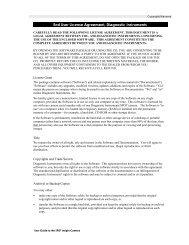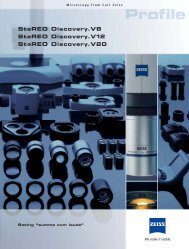optical interference filters - SPOT Imaging Solutions
optical interference filters - SPOT Imaging Solutions
optical interference filters - SPOT Imaging Solutions
You also want an ePaper? Increase the reach of your titles
YUMPU automatically turns print PDFs into web optimized ePapers that Google loves.
Optimizing Filter Sets<br />
for FRET Applications<br />
Application Note<br />
Filters & Microscope Configurations<br />
The filter components required for FRET experiments are not<br />
esoteric. As in any fluo rescence microscopy application, an<br />
excita tion filter is required for exciting the donor fluorophore,<br />
and a dichroic mirror is required for separating donor excitation<br />
energy from both donor and acceptor emis sion energy. Unlike<br />
other fluorescence appli cations, however, two emission <strong>filters</strong> are<br />
required, one for the acceptor fluorophore, or FRET emission,<br />
and one for the donor flu orophore in order to correct for single<br />
bleed thru. As for choosing specific <strong>filters</strong>, the same filter components<br />
and sets can be applicable for FRET as those which are<br />
matched to specific fluo rophores and used in other single color,<br />
epi fluorescence applications.<br />
More important in the selection of <strong>filters</strong> is an understanding of the<br />
physical configura tion of the microscope hardware to be used in<br />
the FRET experiment. At issue are critical experimental variables,<br />
such as time and image registration. While the ideal set-up may<br />
not be affordable or available to all researchers interested in<br />
FRET studies, it is nonetheless important to understand the pros<br />
and cons of the available hardware and filter set configurations.<br />
1. Multi-View Configurations<br />
Most ideal for the viewing and measurement of molecular, proteinprotein<br />
interactions with critical spatial and temporal characteris tic<br />
is a set-up which allows for simultaneous viewing of both donor<br />
and acceptor emis sion energy. This is only possible using a device<br />
which provides a simultaneous split-screen view of the sample.<br />
These multi-view accessories are mounted to the microscope in<br />
front of the detector and use <strong>filters</strong> inte grated into the unit to split<br />
the donor and acceptor emission fluorescence into two images.<br />
When FRET viewing is handled this way, the two critical variables—<br />
time and registra tion—are eliminated. The time of donor and<br />
acceptor imaging is simultaneous, and given a properly aligned<br />
unit, the image registra tion is identical, providing a duplicate view<br />
of the sample. The only difference between the two images is that<br />
one image is captured with an emission filter for donor emission<br />
while the other image uses an emission filter for acceptor emission.<br />
2. Emission Filter Wheels<br />
When multi-view accessories are not avail able, an automated<br />
emission filter wheel is the next best alternative. With this configuration,<br />
a filter cube/holder with a donor excita tion filter and dichroic<br />
mirror are placed in the microscope. The emission <strong>filters</strong> for both<br />
the donor and acceptor fluorophores, in turn, are mounted in the<br />
emission filter wheel, which can be rapidly switched from one to<br />
the other.<br />
Collecting donor and acceptor emission energy using this hardware<br />
configuration, while not simultaneous, can be accom plished with<br />
Overview<br />
FRET, or Forster Resonance Energy Transfer, is a phenomenon<br />
where closely matched pairs of fluorophores are used<br />
to determine spatial or temporal proximity and specificity<br />
in molecular, protein-protein interactions. More specifically,<br />
this energy transfer occurs when the emission energy of<br />
one fluorophore—the donor—is non-radiatively transferred<br />
to the second fluorophore—the acceptor—producing a secondary<br />
emission. When this occurs, donor fluorescence is<br />
quenched and acceptor fluorescence increases.<br />
Biologically, in order for this transfer to occur, the cellular<br />
conditions need to be such that the distance between<br />
the molecules being measured is no more than 1-10nm.<br />
Spectrally, the fluorophores being used need to have a<br />
large overlap, which while creating the conditions for<br />
effective energy transfer, also results in spectral bleed<br />
through (SBT), defined as the overlap of the donor and<br />
acceptor emission spectra, and can be a problem in FRET<br />
measurements.<br />
The development of SBT correction techniques have been<br />
critical to the evolution of FRET as a useful and more widely<br />
used application. These SBT correction techniques—<br />
which include software development, fluorescence<br />
lifetime imaging (FLIM) correlation, and photo bleaching<br />
techniques—have reached a degree of sophistication that<br />
improves the efficacy of FRET. Similarly, the development<br />
of microscopy techniques such as one-photon, two-photon<br />
(multi-photon), confocal, and TIRF are all contributing to<br />
the growing effectiveness and ease of FRET experiments.<br />
While much has been written about the physical and<br />
biological aspects of FRET, as summarized above, this<br />
application note will review the best suited fluorophore<br />
pairs and summarize the considerations surrounding<br />
the hardware configuration and selection of <strong>optical</strong> <strong>filters</strong><br />
required for successful capture, differentiation, and<br />
measurement of FRET.<br />
time delays of only 40-75msec (depending on make and model),<br />
given the state-of-the-art of automated filter wheels as well as<br />
camera and detector technology. Both temporal changes in the<br />
sample during live cell imaging and registration shift result ing<br />
from equipment movement, while almost negated, must still be<br />
considered when ana lyzing experimental results.<br />
3. Separate Filter Cubes<br />
Without a multi-view attachment or emission filter wheel, researchers<br />
must fall back on a third hardware configuration for FRET, which<br />
involves using a separate filter cube for both donor and acceptor<br />
fluorescence. In this con figuration, while each cube has an exciter,<br />
dichroic and emitter, it is extremely impor tant to remember that the<br />
exciter and dichroic in both sets are identical and are those <strong>filters</strong><br />
that are typically used with the donor fluorophore.<br />
For current product listings, specifications, and pricing:<br />
www.omega<strong>filters</strong>.com • sales@omega<strong>filters</strong>.com<br />
1.866.488.1064 (toll free within USA only) • +1.802.254.2690 (outside USA)<br />
89

















